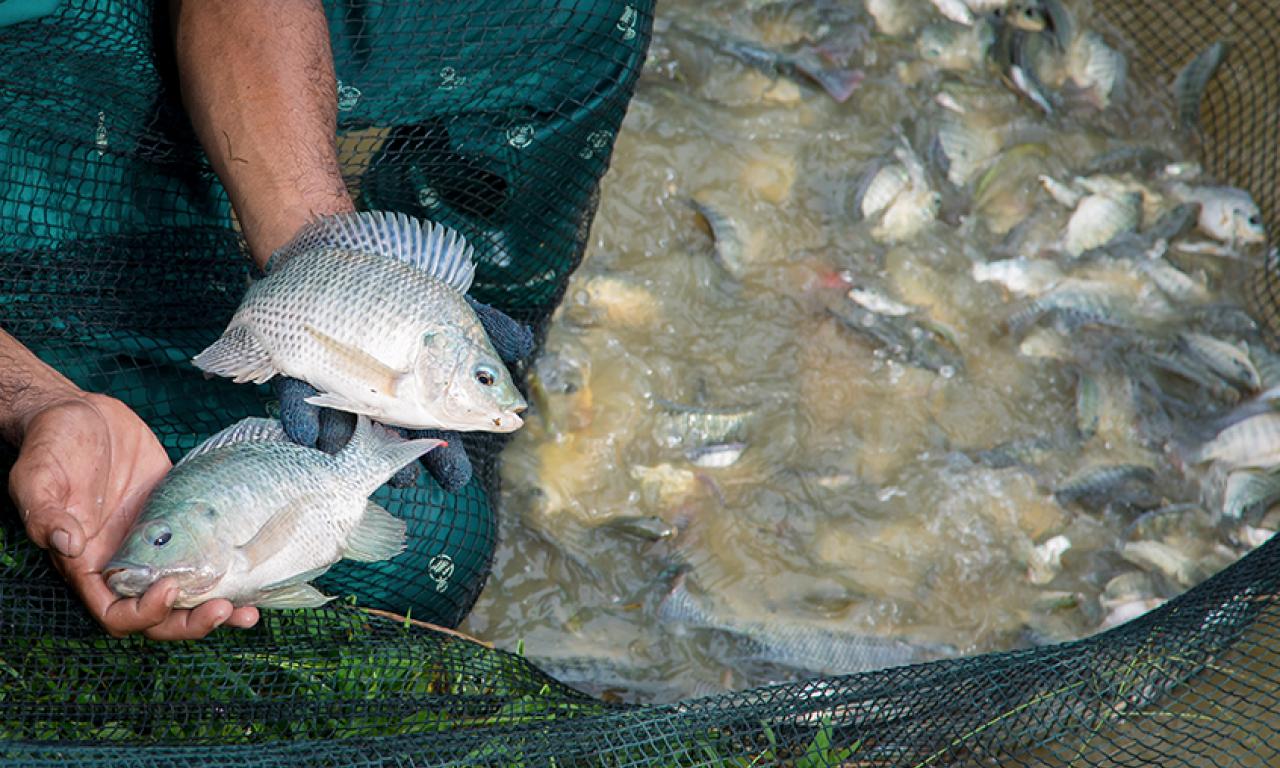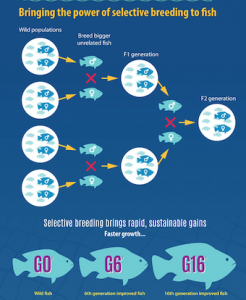
WorldFish work to strengthen the technological foundations of aquaculture made major advances in 2017, with the release of new generations of improved fish lines and the development of molecular markers to facilitate future breeding work.
Recommended publications
- Genetically Improved Farmed Tilapia
- Performance of the Genetically Improved Farmed Tilapia (GIFT) strain over ten generations of selection in Malaysia
WorldFish work to strengthen the technological foundations of aquaculture made major advances in 2017, with the release of new generations of improved fish lines and the development of molecular markers to facilitate future breeding work.
Big strides in delivering improved tilapia strains in Asia and Africa

WorldFish and its partners have been breeding improved tilapia since the late 1980s through the Genetically Improved Farmed Tilapia (GIFT) project and work in Abbassa, Egypt. The latest GIFT generation developed under this project – the 16th – shows that selective breeding for increased growth is still delivering gains of about 10% per generation. The latest generation developed in Malaysia grows nearly twice as fast as the first generation of crossbred fish. In 2016, WorldFish sent fry of this latest generation to the Rajiv Gandhi Center for Aquaculture (RGCA) in India to strengthen its breeding program and to the Department of Fisheries in Myanmar. This is the first time WorldFish has disseminated GIFT fry to Myanmar, which will be used to diversify and improve the genetic quality of tilapia in the country.
The Abbassa strain – now in its 13th generation – is also showing strong gains, and fish farmers are reaping the benefits. “Last year my production using the common strain was around 9.5 metric tons per hectare,” said Mohamed Gamal, an Egyptian fish farmer who received the improved strain Abbassa strain in 2016. ”This year the production of the Abbassa strain reached 12 metric tons per hectare.” Despite the higher price of Abbassa strain fry, farmers are eager to buy more, Gamal stated.
These improved strains of tilapia are spreading rapidly. More than 70% of tilapia production is the Philippines now comes from GIFT or GIFT-derived stock, as does some 50% in Thailand and 20% in Vietnam.
Foundations for carp-breeding program laid
The project’s work on carp species is at an earlier stage, but is hoping for similar impacts. It produced its first selected generation of rohu carp in 2016, and has established base populations of catla and silver carp – the essential first step in developing a selected breeding program.
Not just growth rate
But faster growth alone will not deliver sustainable fish farms that are resilient to climate change and other stresses, and the project is turning its attention to other characters and factors that influence farmers’ fish enterprises. In 2015, the project started looking into whether there is genetic variation for feed conversion in the GIFT strain – are some fish able to grow more on the same amount of food and can they pass this on to their offspring? There are indications from the work in Egypt that the improved Abbassa strain does need less food to achieve the same amount of growth as the local strains. In 2017 the project published a paper that describes, for the first time, an approach to measure feed efficiency traits of individual fish reared in a group – the essential precursor to efforts to breed for increased feed efficiency.
New tools open up new targets for breeding
New genetic tools developed by the project are also expanding the range of traits that breeders can incorporate in their breeding programs, and helping make sure that breeders maintain the genetic diversity of their breeding populations. Project scientists have identified large numbers of single nucleotide polymorphisms – tiny genetic differences that can identify the origins and relationships of individuals – in the three carp species they are working on (Rohu, catla and silver carp) and in tilapia. They are now in the process of using these to avoid crossing closely-related fish in carp-breeding programs in Bangladesh, and to screen the Abbassa strain of tilapia for inbreeding. They have also been used to identify which tilapia strains farmers are using in Bangladesh and the Philippines, giving a first accurate picture of the uptake and spread of the improved lines developed by WorldFish and its partners.
Solid foundations promise bright future
WorldFish’s work on selective breeding of tilapia and carp populations and new tools to support this have laid solid foundations for fish-based aquaculture throughout Africa and Asia. It places the organization at the forefront of efforts to provide small-scale fish farmers and their families with greater food and nutrition security and a brighter future.
About the project
The project, Improving the technological foundations for sustainable aquaculture, is funded by the European Commission and the International Fund for Agricultural Development.